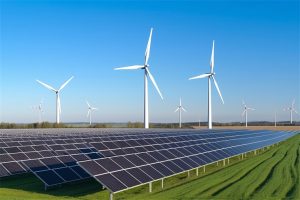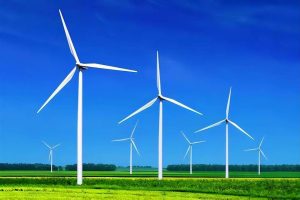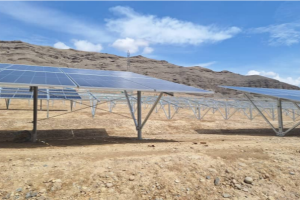Peralihan global ke arah tenaga bersih telah mempercepatkan secara dramatik pada tahun -tahun kebelakangan ini ketika negara berusaha memerangi perubahan iklim dan mengurangkan pelepasan gas rumah hijau. Oleh 2025, Industri Tenaga Bersih dijangka mencapai ketinggian baru, didorong oleh kemajuan teknologi, perubahan dasar, dan peningkatan permintaan untuk sumber kuasa lestari. Ramalan ini akan meneroka faktor utama yang membentuk landskap tenaga bersih, memberi tumpuan kepada perkembangan teknologi tenaga boleh diperbaharui, Dinamika Pasaran, Sokongan dasar, dan cabaran yang mungkin timbul di sepanjang jalan.

Trend ramalan utama untuk industri tenaga bersih di 2025
Pertumbuhan kapasiti tenaga solar dan angin
Tenaga Suria dan Angin telah menubuhkan diri mereka sebagai sumber tenaga boleh diperbaharui yang terkemuka di seluruh dunia, dan pertumbuhan mereka dijangka berterusan 2025. Menurut Agensi Tenaga Antarabangsa (IEA), Kapasiti PV solar dijangka melepasi 1,500 Gigawatts (GW) oleh 2025, hampir dua kali ganda dari tahap semasa. Kos pembuatan panel solar yang merosot, Kemajuan dalam kecekapan, dan penggunaan sistem solar atas bumbung yang meluas adalah pemacu utama pertumbuhan ini.
Tenaga angin, Kedua -dua darat dan luar pesisir, juga ditetapkan untuk berkembang dengan ketara. Angin luar pesisir, khususnya, menjadi lebih berdaya maju kerana inovasi teknologi seperti turbin terapung, yang membolehkan pemasangan di perairan yang lebih dalam. Kapasiti angin luar pesisir global dijangka dapat dicapai 234 GW 2025, naik dari 50 Gw masuk 2021. Perkembangan ini disokong oleh projek berskala besar di Eropah, A.S., dan China, di mana kerajaan membuat pelaburan besar dalam infrastruktur tenaga bersih.
Penyelesaian penyimpanan tenaga dan integrasi grid
Salah satu cabaran utama tenaga boleh diperbaharui adalah intermittency, yang merujuk kepada ketidakkonsistenan penjanaan kuasa dari sumber solar dan angin. Sistem Penyimpanan Tenaga, terutamanya bateri lithium-ion, menjadi penting untuk mengimbangi bekalan dan permintaan. Dalam 2025, Penyimpanan bateri dijangka berkembang pesat, dengan saiz pasaran melebihi $19 bilion di seluruh dunia. Kemajuan dalam teknologi penyimpanan tenaga, termasuk bateri yang lebih tahan lama dan lebih cekap, akan meningkatkan kestabilan grid dan memudahkan integrasi tenaga boleh diperbaharui yang lebih tinggi.
Melebihi simpanan, Teknologi Grid Pintar dijangka memainkan peranan penting dalam menguruskan sumber tenaga yang diedarkan dan mengintegrasikan tenaga bersih ke dalam infrastruktur kuasa yang ada. Grid Pintar Gunakan Analisis Data Lanjutan, Kecerdasan Buatan (Ai), dan pemantauan masa nyata untuk mengoptimumkan pengagihan tenaga, mengurangkan gangguan, dan kos operasi yang lebih rendah.

Pengembangan pengeluaran hidrogen hijau
Hidrogen Hijau, dihasilkan menggunakan tenaga boleh diperbaharui melalui elektrolisis, muncul sebagai pemain utama dalam campuran tenaga bersih. Ia dilihat sebagai penyelesaian untuk menghancurkan sektor yang sukar dikecualikan seperti industri berat, pengangkutan, dan pemanasan. Oleh 2025, Pengeluaran hidrogen hijau global dijangka berkembang dengan ketara, dengan pelaburan dijangka menjangkau $70 bilion.
Negara seperti Jerman, Jepun, Dan Australia memimpin jalan dalam membangunkan projek hidrogen hijau, didorong oleh sokongan kerajaan yang kuat dan komitmen korporat untuk mencapai pelepasan net-sifar. Sebagai tambahan, Banyak syarikat meneroka hidrogen hijau sebagai cara untuk menyimpan kelebihan tenaga boleh diperbaharui, Meningkatkan lagi rayuannya sebagai pembawa tenaga masa depan.
Kenderaan elektrik (Evs) dan mobiliti bersih
Peralihan ke kenderaan elektrik bersedia untuk mempercepatkan 2025, didorong oleh inisiatif dasar, Kemajuan dalam Teknologi Bateri, dan meningkatkan permintaan pengguna. Bloombebnef meramalkan bahawa jualan EV akan dibuat 20% dari semua jualan kereta baru oleh 2025, naik dari adil 4% dalam 2020. Penerimaan EVs akan memberi kesan kepada permintaan elektrik, Memerlukan pelaburan selanjutnya dalam mengecas infrastruktur dan penjanaan kuasa bersih untuk menyokong armada kereta elektrik yang semakin meningkat.
Kerajaan di seluruh dunia melaksanakan peraturan pelepasan yang ketat dan menawarkan insentif untuk pembelian EV, yang memacu peralihan mobiliti yang bersih. Pembuat kereta juga melangkah pengeluaran model EV mereka, dengan ramai yang melakukan fasa enjin pembakaran dalaman (Ais) kenderaan sepenuhnya dalam dekad yang akan datang. Peralihan ini dijangka meningkatkan permintaan untuk elektrik dan penyimpanan tenaga yang boleh diperbaharui, terutamanya semasa masa pengecasan puncak.
Sokongan dasar dan kerjasama global
Kejayaan industri tenaga bersih di 2025 sebahagian besarnya bergantung pada kesinambungan sokongan dasar yang kukuh di peringkat kebangsaan dan antarabangsa. Kerajaan di seluruh dunia melaksanakan dasar dan peraturan untuk menggalakkan penggunaan tenaga boleh diperbaharui, Kurangkan pelepasan karbon, dan Menyokong kecekapan tenaga. khususnya, A.S., Kesatuan Eropah, Dan China dijangka kekal sebagai pemain utama dalam memajukan inisiatif tenaga bersih.
Komitmen pentadbiran Biden untuk mencapai 100% elektrik bersih oleh 2035 telah memacu pelaburan yang signifikan dalam projek tenaga boleh diperbaharui, dengan tumpuan solar, angin, dan penyimpanan bateri. Begitu juga, Perjanjian Hijau Kesatuan Eropah bertujuan menjadikan iklim EU-Neutral oleh 2050, dengan sasaran tenaga boleh diperbaharui yang bercita -cita tinggi untuk 2030 dan seterusnya.
Kerjasama antarabangsa juga akan memainkan peranan penting dalam memajukan peralihan tenaga bersih. Inisiatif Global Seperti Perjanjian Paris Terus Memacu Usaha Kerjasama, Walaupun organisasi seperti Agensi Tenaga Diperbaharui Antarabangsa (Irena) dan IEA berusaha untuk mempromosikan amalan terbaik dan menyokong dasar tenaga bersih.

Decarbonisasi industri berat
Industri seperti keluli, simen, dan bahan kimia adalah antara sektor yang paling intensif karbon. Decarbonizing Industries ini penting untuk mencapai matlamat iklim global, dan oleh 2025, Kami mengharapkan untuk melihat kemajuan selanjutnya di kawasan ini. Penyelesaian seperti hidrogen hijau, Elektrik, dan penangkapan karbon, penggunaan, dan penyimpanan (Ccus) mendapat daya tarikan sebagai pilihan yang sesuai untuk mengurangkan pelepasan dalam industri ini.
Kerajaan dan syarikat sama -sama melabur dalam projek perintis untuk menguji kemungkinan teknologi ini secara berskala. Sebagai contoh, keluli hijau Pengeluaran menggunakan hidrogen sebagai ejen pengurangan sedang diterokai di Eropah, Walaupun beberapa projek CCU sedang dijalankan di Amerika Utara dan Timur Tengah.
Cabaran yang dihadapi industri tenaga bersih di 2025
Kesesakan rantaian bekalan
Industri tenaga bersih sangat bergantung pada bahan mentah kritikal seperti litium, Cobalt, dan elemen nadir bumi untuk pembuatan bateri, panel solar, dan turbin angin. Gangguan rantaian bekalan, Ketegangan geopolitik, dan kekurangan sumber boleh menimbulkan cabaran yang signifikan kepada pertumbuhan industri dalam 2025.
Untuk mengurangkan risiko ini, Syarikat dan kerajaan meneroka program kitar semula, bahan alternatif, dan peluang perlombongan domestik. Namun begitu, Memastikan bekalan bahan -bahan ini yang stabil dan mampan tetap menjadi kebimbangan untuk pasaran tenaga bersih global.
Membiayai peralihan tenaga
Peralihan tenaga memerlukan pelaburan modal yang besar, terutamanya di negara -negara membangun di mana akses tenaga masih terhad. Oleh 2025, Jumlah pelaburan yang diperlukan untuk mencapai sasaran tenaga bersih dianggarkan melebihi $4 trilion setiap tahun. Mengamankan pembiayaan ini, terutamanya dalam menghadapi ketidakpastian ekonomi, adalah cabaran utama bagi kerajaan, perniagaan, dan pelabur.
Mekanisme pembiayaan inovatif, seperti bon hijau dan perkongsian awam-swasta, membantu menutup jurang, Tetapi lebih banyak usaha diperlukan untuk memastikan projek tenaga bersih menerima pembiayaan yang diperlukan untuk penggunaan berskala besar.

Kestabilan dan ketahanan grid
Oleh kerana lebih banyak sumber tenaga boleh diperbaharui datang dalam talian, memastikan kestabilan dan ketahanan grid kuasa akan menjadi semakin penting. Sifat sekejap tenaga solar dan angin menimbulkan cabaran kepada pengendali grid, siapa yang mesti bekalan pembolehubah baki dengan permintaan yang berubah -ubah. Sistem Pengurusan Grid Lanjutan, Penyimpanan Tenaga, dan penyelesaian tindak balas permintaan adalah penting untuk menangani cabaran ini.
Selain itu, Perubahan iklim sendiri memberikan ancaman kepada infrastruktur tenaga, dengan peristiwa cuaca yang melampau seperti taufan, banjir, dan gelombang panas menjadi lebih kerap. Meningkatkan ketahanan grid kuasa untuk menahan peristiwa -peristiwa ini adalah keutamaan yang semakin meningkat bagi sektor tenaga.
Kesimpulan
Industri Tenaga Bersih berada di ambang transformasi utama, dengan 2025 menandakan tahun penting dalam peralihan tenaga global. Pertumbuhan pesat sumber tenaga boleh diperbaharui, kebangkitan kenderaan elektrik, Kemajuan dalam penyimpanan tenaga, Dan kemunculan hidrogen hijau semuanya mendorong perubahan ini. Namun begitu, Cabaran seperti gangguan rantaian bekalan, jurang pembiayaan, dan kestabilan grid mesti ditangani untuk memastikan kejayaan berterusan industri.
Dengan memberi tumpuan kepada inovasi, Sokongan dasar, dan kerjasama antarabangsa, sektor tenaga bersih dapat mencapai sasaran yang bercita -cita tinggi untuk 2025 dan seterusnya, membuka jalan untuk masa depan tenaga yang lebih mampan dan berdaya tahan.



